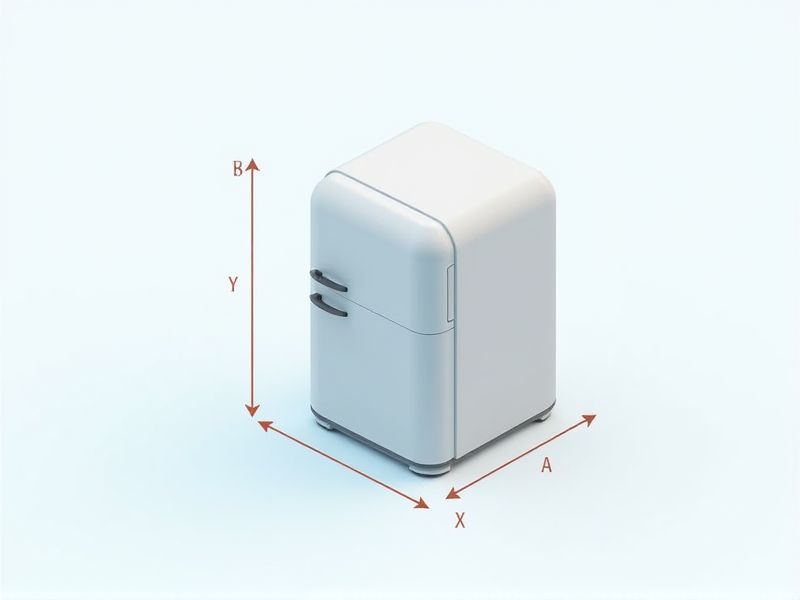
When choosing a mini fridge, it's important to know that standard dimensions typically range from 18 to 20 inches in width, 19 to 22 inches in depth, and 30 to 35 inches in height. These compact sizes make mini fridges ideal for dorm rooms, bedrooms, or offices where space is limited. Always double-check the product specifications before purchasing, as some models may be slightly larger or smaller than others. By considering your available space and measuring carefully, you can ensure your new mini fridge will fit comfortably where you need it.
Cubic Feet Capacity
Mini fridges typically range from 1.7 to 3.5 cubic feet in capacity, making them ideal for small spaces, dorm rooms, or office setups. A 2.5 cubic feet mini fridge can generally accommodate approximately 36 cans, while a larger model can hold up to 60. When selecting your mini fridge, consider how much storage you need for beverages, snacks, or meal prep. It's also important to note that the more compact designs usually come with a freezer compartment, offering added versatility for frozen items.
Height In Inches
The average height of a mini fridge typically ranges from 20 to 34 inches, making it a compact solution for small spaces and dorm rooms. Many models come with adjustable shelves, allowing for optimal storage of beverages and snacks while minimizing wasted space. If you're considering purchasing one, look for units with a height that fits comfortably beneath countertops or in your desired location. Remember, selecting the right height not only enhances functionality but also complements your room's overall aesthetic.
Width In Inches
The standard width of a mini fridge typically ranges from 18 to 24 inches, making it a versatile choice for various spaces. Compact models often measure around 20 inches wide, ideal for dorm rooms, office desks, or small apartments. It's essential to consider the available space before purchasing, as wider models may offer more storage capacity, generally accommodating 1.7 to 3.2 cubic feet. Evaluating dimensions ensures you select a mini fridge that fits seamlessly into your environment while meeting your refrigeration needs.
Depth In Inches
When selecting a mini fridge, the standard depth typically ranges from 17 to 24 inches. These dimensions ensure the fridge can fit conveniently under countertops or in tight spaces without compromising its storage capacity. Depending on your needs, some models offer adjustable shelves to maximize storage efficiency despite limited depth. Ensure your chosen mini fridge's depth aligns with your available space to optimize functionality and accessibility.
Adjustable Shelves
Mini fridges featuring adjustable shelves provide unparalleled flexibility, accommodating items of various sizes. Most models allow you to modify the height of each shelf, with options typically ranging from 3 to 5 shelves, ensuring optimal space utilization. This feature is especially beneficial for storing tall bottles or containers, as it enables customization to fit your specific needs. When selecting a mini fridge, consider one with adjustable shelving for enhanced organization and efficient use of interior space.
Energy Efficiency Rating
Energy Efficiency Rating (EER) is a crucial standard for mini fridges, indicating their performance and power consumption levels. An EER of 9 or higher is typically considered energy-efficient, helping you save on electricity bills while reducing your carbon footprint. For example, opting for a mini fridge with an Energy Star certification can lower energy use by about 10-50% compared to standard models. By selecting an energy-efficient mini fridge, you can enjoy optimal cooling with minimal environmental impact.
Reversible Door
A reversible door feature in a mini fridge allows you to customize its configuration to fit your space efficiently, accommodating different layouts and preferences. Most mini fridges with this option offer a hinge that can be adjusted to open from either the left or right side, enhancing accessibility. This flexibility is particularly valuable in small apartments or dorm rooms where space is limited and you may need to reposition your fridge frequently. You can consider models with energy-efficient ratings, as many reversible door mini fridges consume between 100 to 200 kilowatt-hours annually, contributing to lower utility bills.
Temperature Control Settings
Mini fridges typically offer multiple temperature control settings, often ranging from 32degF to 50degF (0degC to 10degC), allowing you to store food and beverages at optimal temperatures. Many models feature adjustable thermostats that let you fine-tune the cooling level based on your specific needs, ensuring freshness and safety. Energy-efficient mini fridges are designed to maintain consistent temperatures while consuming less power, often rated under 200 kWh annual energy consumption. When selecting a mini fridge, consider units with internal thermometers for real-time monitoring, providing peace of mind about food preservation.
Noise Level
Noise level is a crucial factor to consider when selecting a mini fridge, typically measured in decibels (dB), with quieter models operating around 35 dB, comparable to a whisper. Many consumers prefer mini fridges that fall within the 40-50 dB range, as this ensures a relatively silent background that won't disrupt daily activities. Look for brands that specifically advertise low-noise technology or soundproof insulation, as these features can significantly enhance your overall experience. Choosing a mini fridge with an optimal noise level not only contributes to a peaceful environment but also reflects the quality and efficiency of the appliance.
Weight Load Capacity
The weight load capacity of mini fridges typically ranges from 50 to 150 pounds, depending on the model and design specifications. When selecting a mini fridge for your space, consider the type and quantity of items you intend to store, as exceeding the weight limit can lead to inefficiency or mechanical issues. Ensure that your fridge has adequate shelving support, as most mini fridges come with adjustable shelves designed to accommodate various storage needs. Always check the manufacturer's specifications to determine the optimal weight limit for your specific mini fridge model.
